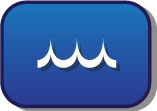
It’s hard to imagine life on Earth without oceans. The air you breathe used to be an ocean breeze. The water you drink was once in a cloud over the ocean.
The ocean is also important to the many species of plants and animals that call the water their home. This community of organisms is called an ecosystem.
Human-caused climate change is warming our planet, and the oceans are feeling the heat. Plants and animals in the ocean ecosystem are sensitive to changes in the ocean’s temperature. Some organisms can adapt to the change, but others can’t survive the warmer temperatures. Since so much life is dependent on these waters, it’s important to keep the oceans healthy!
Scientists are monitoring the temperature of the ocean with an instrument called the Moderate Resolution Imaging Spectroradiometer (MODIS) on NASA’s Aqua satellite. The satellite measures the temperature of the top millimeter of the ocean’s surface.
With this activity, learn to make a cool and tasty version of the ocean ecosystem at home!
What you need:

- A large, clear bowl
- 2 – 6 oz boxes of blue gelatin dessert mix
- Red licorice twists
- Gummy fish
- Scissors
- Mint leaves
- Hot water
- Cold water
- Liquid measuring cup (not pictured)
- Spoon (not pictured)
What to do:
- Make the ocean water. Follow the directions on the box of blue gelatin dessert mix by pouring 2 cups of hot water into the bowl with 2 packages of blue gelatin powder. Stir for 2 minutes. Once the powder is dissolved, mix in 2 cups of cold water. Place the bowl in the refrigerator for approximately 45 minutes.
- Make the coral. While the gelatin is in the refrigerator, use the scissors to cut the red licorice strips into short sections that are only a few inches long. The licorice will represent the coral in your edible ecosystem.
- Make the seaweed. Cut the mint into segments approximately 2 to 3 inches long. The mint leaves will represent the seaweed in your edible ocean ecosystem.
- Remove gelatin from refrigerator. After 45 minutes has passed, remove your gelatin from the refrigerator. It should be thicker than liquid, but not completely firm. If the gelatin is still very runny, place it back in the refrigerator for 10 minutes and check it again.
- Assemble your ocean ecosystem. Once the gelatin has become a thick liquid, begin placing your seaweed (mint), coral (licorice), and fish (gummy fish) in the ocean of blue gelatin. Push each item into the gelatin with your finger. Be sure to place some of your fish, coral, and seaweed right next to the glass so that they’re easy to see. When you’re done, jiggle the gelatin a bit to repair the holes.
- Refrigerate the gelatin again. Place gelatin in the refrigerator for another 2 to 3 hours. This will allow the gelatin to become totally firm.
- Admire and enjoy your tasty ocean-themed dessert!
Note: This amount of time should allow the gelatin to become a thick liquid that is only slightly firm.




















